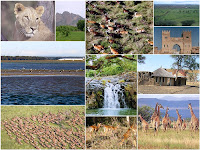Facts And Things You Should Know About Snow Leopards
The Snow Leopard. They scale the great, steep slopes of mountains in Central Asia with ease, blending into the landscape. They are known for their beautiful, thick fur, with white, yellowish or soft gray coat and ringed spots of black on brown - which help camouflage them from prey. Here are some basic facts about these beautiful cats:
+ Defenders
+ National Geographic
+ More Detailed Facts: Snow Leopard Trust
+ Arkive
+ BBC Nature
+ Google Images
+ Google Videos
- There are endangered and are believed to be fewer than 7,000 snow leopards in the wild and about 600 to 700 in zoos around the world.
- They are solitary and elusive nature.
- They are found at altitudes between 9,800 and 17,000 feet in the high, rugged mountains of Central Asia. Their range spans from Afghanistan to Kazakhstan and Russia in the north to India and China in the east. China contains about 60% of snow leopard habitat. They have already disappeared from certain parts of Mongolia, which is part of their historic range.
- Humans are the sole predator of snow leopards, just as we are the sole predators of most endangered animals on Earth. Head and body length is 47-59 inches, while the long, thick tail is 31-39 inches long. They use it for balance when moving and extra warmth at rest, when it’s wrapped around the body and face.
- Snow leopards have very large paws that act as snowshoes and keep them from sinking into the snow. Their paws are also completely fur-covered, protecting them from the cold.
- They prefer to inhabit steep cliff areas, rocky outcrops and ravines. They can spring from a distance of 20 - 50 feet when stalking their prey. Their prey include blue sheep (bharal) of Tibet and the Himalaya, as well as the mountain ibex found over most of the rest of their range. Though these powerful predators can kill animals three times their weight, they also eat smaller fare, such as marmots, hares, and game birds.
- One Indian snow leopard, protected and observed in a national park, is reported to have consumed five blue sheep, nine Tibetan woolly hares, twenty-five marmots, five domestic goats, one domestic sheep, and fifteen birds in a single year. The habitat of the snow leopard continues to decline as increased grazing and human settlements fragment the historic range of the species.
- Survival Threats: Poaching for the fur trade, loss of habitat caused by deforestation and dam projects, and loss of food sources caused by similar environmental pressures.
- Mostly active at dawn and dusk, snow leopards are rarely seen in the wild. Unlike other big cats, snow leopards are unable to roar. Solitary in nature, they pair only during the breeding season.
- Reproduction: Mating Season -Between January and mid-March. Gestation: period 3-3 ½ months. Litter size: 2-3 cubs.
- Fast Facts: Height - About 2 feet (.6m) at shoulders. Length - 6-7.5 feet (1.8-2.3m) (includes 40-inch (1m) tail length). Weight - 77-120 lbs (35-55 kg). Female snow leopards are about 30% smaller than males. Lifespan - Their reclusive nature makes it hard to determine snow leopard lifespan in the wild. They have, however, been known to live for as long as 21 years in captivity.
+ Defenders
+ National Geographic
+ More Detailed Facts: Snow Leopard Trust
+ Arkive
+ BBC Nature
+ Google Images
+ Google Videos



